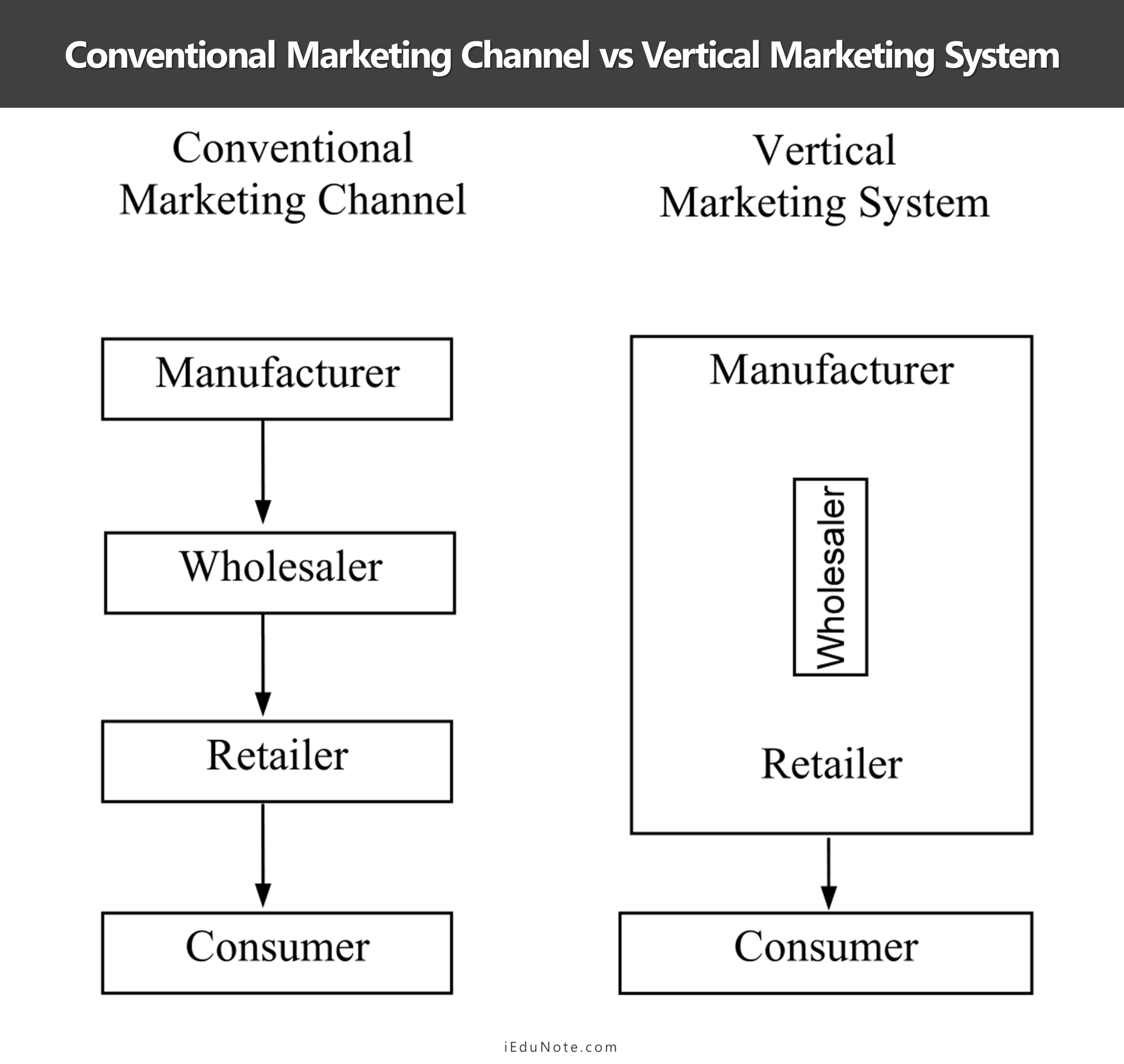The vertical marketing system is a recent development that has emerged to challenge conventional marketing channels. Let’s contrast the two types of channel arrangements. A conventional distribution channel consists of one or more independent producers, wholesalers, and retailers.
Each is a separate business seeking to maximize its profits, even at the expense of profits for the system. No channel member has much control over the other members, and no formal means exist for assigning roles and resolving channel conflict.
Table of Contents:
Vertical Marketing Systems
In contrast, a vertical marketing system (VMS) consists of producers, wholesalers, and retailers acting as a unified system.

The producer, wholesaler, or retailer can control the VMS.
Vertical marketing systems came into being to control channel behavior and manage channel conflict. They achieve economics through size, bargaining power, and elimination of duplicated services.
We will now discuss the three types of VMS shown in the figure. Each type adopts a different means of setting up leadership and power in the channel. Coordination and conflict management are achieved through common ownership at different channel levels in a corporate VMS.
In a contractual VMS, they are achieved through contractual agreements among channel members. One or a few dominant channel members assume leadership in an administered VMS.
Each type of VMS is described in the following discussion:
- Corporate VMS
- Contractual VMS
- Administered VMS
Corporate VMS
A corporate VMS integrates various stages of production and distribution under single ownership. Cooperation and conflict management are handled through regular organizational channels. For example, Sears obtains more than 50 percent of its goods from companies partly or wholly.
Contractual VMS
A contractual VMS consists of independent firms at different production levels and distribution who join together through contracts to secure more economies or sales than each could achieve individually.
There are three types of contractual VMS;
- wholesaler-sponsored voluntary chains,
- retailer cooperatives, and
- franchise organizations.
Wholesaler-sponsored voluntary chains
Wholesaler-sponsored voluntary chains are systems where wholesalers organize voluntary chains of independent retailers to help them compete with large chain organizations.
Retailer Cooperatives
Retailer cooperatives are systems where retailers organize a new, jointly owned business to conduct wholesaling and possibly production. Members of such cooperatives buy most of their goods through the retailer cooperatives and plan their promotion jointly.
Franchise Organizations
In franchise organizations, a channel member, a franchiser, connects several stages in the production-distribution process.
There are three types of franchises are;
- the manufacturer-sponsored retailer franchise system
- the manufacturer-sponsored wholesaler franchise system
- the service-firm-sponsored retailer franchise system
The first form is the manufacturer-sponsored retailer franchise system in the automobile industry.
The second type of franchise is the manufacturer-sponsored wholesaler franchise system, as found in the soft-drink industry.
The third franchise form is the service-firm-sponsored retailer franchise system. A service firm licenses a retailer’s system to bring its service to consumers, as found in the auto-rental business.
Administered VMS
An administered VMS coordinates successive stages of production and distribution.
Administered VMS emerges not through common ownership or contractual ties but also one of the parties’ sizes and power. Manufacturers of a highly established brand can get strong trade cooperation and support from resellers.
For example, General Electric and Procter & Gamble can command cooperation from resellers regarding displays, shelf space, promotions, and price policies.
Horizontal Marketing Systems
In a horizontal marketing system, two or more companies at one level join together to exploit a new marketing opportunity.
Companies can combine their capital, product capabilities, or marketing resources to accomplish more than any company working alone. They might work with each other on a temporary or permanent basis. They may even form a separate company.
Coca-Cola and Nestle set a joint venture to market ready-to-drink coffee and tea worldwide. Coca provided worldwide experience in marketing and distributing beverages, and Nestle contributed to two established brand names-Nescafe and Nestea.
Such channel arrangements work well globally. The number of such horizontal marketing systems has increased dramatically in recent years.
Hybrid Marketing Systems
Hybrid marketing systems are multichannel distribution systems in which a single firm sets up two or more marketing channels to reach one or more customer segments.
The figure below shows a hybrid channel. In the figure, the producer sells directly to consumer segment-1 using direct-mail catalogs and telemarketing and reaches consumer segment-2 through the retailer.
It sells indirectly to Business segment-1 through distributors and dealers and Business segment-2 through its sales force.
IBM provides a good example of a company that uses such a hybrid channel effectively. For years, IBM sold computers only through its own sales force.
However, when the market for small, low-cost computers exploded, this single channel was no longer adequate. To serve the diverse needs of the many segments in the rapidly fragmenting computer market, IBM added 18 new channels in less than ten years.
Companies facing big and complex markets can benefit from hybrid channels.
With the introduction of each new channel, companies’ sales and market coverage expand. The company also gains opportunities to design its products and services for diverse customer segments’ needs.
But companies may sometime find hybrid channels harder to control. These channels also tend to generate conflict as more channels compete for customers and sales. It is often found that the multichannel marketer’s channels are all under its ownership and control.
Although this arrangement eliminates conflict with outside channels, the company might face internal conflict over how much financial support each channel deserves.